*NURSING > EXAM > NR 509 Advanced Physical Assessment quiz 3 | Guaranteed Pass | most tested questions in NR 509 | Cha (All)
NR 509 Advanced Physical Assessment quiz 3 | Guaranteed Pass | most tested questions in NR 509 | Chamberlain College of Nursing
Document Content and Description Below
Advanced Physical Assessment quiz 3 1. Question : A patient tells the nurse that he has noticed that one of his moles has started to burn and bleed. When assessing his skin, the nurse wo... uld pay special attention to the danger signs for pigmented lesions and would be concerned with which additional finding? Student Answer: Color variation Border regularity Symmetry of lesions Diameter less than 6 mm Instructor Explanation: Abnormal characteristics of pigmented lesions are summarized in the mnemonic ABCD: asymmetry of pigmented lesion, border irregularity, color variation, and diameter greater than 6 mm. Points Received: 2 of 2 Comments: Question 2.Question : The nurse is bathing an 80-year-old man and notices that his skin is wrinkled, thin, lax, and dry. This finding would be related to which factor? Student Answer: Increased vascularity of the skin in the elderly Increased numbers of sweat and sebaceous glands in the elderly An increase in elastin and a decrease in subcutaneous fat in the elderly An increased loss of elastin and a decrease in subcutaneous fat Instructor Explanation: in the elderly An accumulation of factors place the aging person at risk for skin disease and breakdown: the thinning of the skin, the decrease in vascularity and nutrients, the loss of protective cushioning of the subcutaneous layer, a lifetime of environmental trauma to skin, the social changes of aging, the increasingly sedentary lifestyle, and the chance of immobility. Points Received: 2 of 2 Comments: Question 3.Question : A patient comes to the clinic and tells the nurse that he has been confined to his recliner chair for about three days with his feet down and he wants the nurse to evaluate his feet. During the assessment, the nurse might expect to find Student Answer: pallor. coolness. distended veins. prolonged capillary filling time. Instructor Explanation: Keeping the feet in a dependent position causes venous pooling, resulting in redness, warmth, and distended veins. Prolonged elevation would cause pallor and coolness. Immobilization or prolonged inactivity would cause prolonged capillary filling time. See Table 12-1. Points Received: 2 of 2 Comments: Question 4.Question : A 65-year-old man with emphysema and bronchitis has come to the clinic for a follow-up appointment. On assessment, the nurse might expect to see which assessment finding? Student Answer: Anasarca Scleroderma Pedal erythema Clubbing of the nails Instructor Explanation: Clubbing of the nails occurs with congenital cyanotic heart disease, neoplastic, and pulmonary diseases. The other responses are assessment findings not associated with pulmonary diseases. Points Received: 2 of 2 Comments: Question 5.Question : The nurse notices that a school-aged child has bluish-white, red- based spots in her mouth that are elevated about 1 mm to 3 mm. What other signs would the nurse expect to find in this patient? Student Answer: A pink, papular rash on the face and neck Pruritic vesicles over her trunk and neck Hyperpigmentation on the chest, abdomen, and the back of the arms A red-purple, maculopapular, blotchy rash behind the ears and Instructor Explanation: on the face With measles (rubeola), the examiner would assess a red-purple, blotchy rash on the third or fourth day of illness that appears first behind the ears and spreads over the face and then over the neck, trunk, arms and legs. It looks coppery and does not blanch. The bluish-white, red-based spots in the mouth are known as Koplik’s spots. Points Received: 2 of 2 Comments: Question 6.Question : During an examination, the nurse knows that Paget’s disease would be indicated by which of these assessment findings? Student Answer: Positive Macewen sign Premature closure of the sagittal suture Headache, vertigo, tinnitus, and deafness Elongated head with heavy eyebrow ridge Instructor Explanation: Paget’s disease occurs more often in males and is characterized by bowed long bones, sudden fractures, and enlarging skull bones that press on cranial nerves causing symptoms of headache, vertigo, tinnitus, and progressive deafness. Points Received: 2 of 2 Comments: Question 7.Question : A mother brings her newborn in for an assessment and asks, “Is there something wrong with my baby? His head seems so big.” The nurse recognizes that which statement is true regarding the relative proportions of the head and trunk of the newborn? Student Answer: At birth, the head is one fifth the total length. Head circumference should be greater than chest circumference at birth. The head size reaches 90% of its final size when the child is 3 years old. When the anterior fontanel closes at 2 months, the head will be Instructor Explanation: more proportioned to the body. During the fetal period, head growth predominates. Head size is greater than chest circumference at birth, and the head size grows during childhood, reaching 90% of its final size when the child is age 6 years. Points Received: 2 of 2 Comments: Question 8.Question : A male patient with a history of AIDS has come in for an examination and he states, “I think that I have the mumps.” The nurse would begin by examining the Student Answer: thyroid gland. parotid gland. cervical lymph nodes. mouth and skin for lesions. Instructor Explanation: The parotid gland may become swollen with the onset of mumps, and parotid enlargement has been found with HIV. Points Received: 2 of 2 Comments: Question 9.Question : A patient visits the clinic because he has recently noticed that the left side of his mouth is paralyzed. He states that he cannot raise his eyebrow or whistle. The nurse suspects that he has Student Answer: Cushing’s syndrome. Parkinson disease. Bell’s palsy. had a cerebrovascular accident (stroke). Instructor Explanation: With an upper motor neuron lesion (as with CVA), the patient will have paralysis of lower facial muscles, but the upper half of the face is not affected owing to the intact nerve from the unaffected hemisphere. The person is still able to wrinkle the forehead and close the eyes. See Table 13-4, Abnormal Facial Appearances with Chronic Illnesses for descriptions of the other responses. Points Received: 2 of 2 Comments: Question 10.Question : The nurse is performing an eye-screening clinic at a daycare center. When examining a 2-year-old child, the nurse suspects that the child has “lazy eye” and should Student Answer: examine the external structures of the eye. assess visual acuity with the Snellen eye chart. assess the child’s visual fields with the confrontation test. test for strabismus by performing the corneal light reflex test. Instructor Explanation: Testing for strabismus is done by performing the corneal light reflex test as well as the cover test. The Snellen eye chart and confrontation test are not used to test for strabismus. Points Received: 2 of 2 Comments: Question 11.Question : During an ophthalmoscopic examination of the eye, the nurse notices areas of exudate that look like “cotton wool” or fluffy gray- white cumulus clouds. This finding indicates which possible problem? Student Answer: Diabetes Hyperthyroidism Glaucoma Hypotension Instructor Explanation: Soft exudates or “cotton wool” areas look like fluffy gray-white cumulus clouds. They occur with diabetes, hypertension, subacute bacterial endocarditis, lupus, and papilledema of any cause. These exudates are not found with hyperthyroidism, glaucoma, or hypotension. Points Received: 2 of 2 Comments: Question 12.Question : When examining the eye, the nurse notices that the patient’s eyelid margins approximate completely. The nurse recognizes that this assessment finding Student Answer: is expected. may indicate a problem with extraocular muscles. may result in problems with tearing. indicates increased intraocular pressure. Instructor Explanation: The palpebral fissure is the elliptical open space between the eyelids, and when closed, the lid margins approximate completely, which is a normal finding. Points Received: 2 of 2 Comments: Question 13.Question : A mother asks when her newborn infant’s eyesight will be developed. The nurse should reply Student Answer: “Vision is not totally developed until 2 years of age.” “Infants develop the ability to focus on an object at around 8 months.” “By about 3 months, infants develop more coordinated eye movements and can fixate on an object.” “Most infants have uncoordinated eye movements for the first Instructor Explanation: year of life.” Eye movements may be poorly coordinated at birth, but by 3 to 4 months of age, the infant should establish binocularity and should be able to fixate on a single image with both eyes simultaneously. Points Received: 2 of 2 Comments: Question 14.Question : In performing an examination of a 3-year-old with a suspected ear infection, the nurse would Student Answer: omit the otoscopic examination if the child has a fever. pull the ear up and back before inserting the speculum. ask the mother to leave the room while examining the child. perform the otoscopic examination at the end of the assessment. Instructor Explanation: In addition to its place in the complete examination, eardrum assessment is mandatory for any infant or child requiring care for illness or fever. For the infant or young child, the timing of the otoscopic examination is best toward the end of the complete examination. Points Received: 2 of 2 Comments: Question 15.Question : The nurse is taking the history of a patient who may have a perforated eardrum. What would be an important question in this situation? Student Answer: “Do you ever notice ringing or crackling in your ears?” “When was the last time you had your hearing checked?” “Have you ever been told you have any type of hearing loss?” “Was there any relationship between the ear pain and the Instructor Explanation: discharge you mentioned?” Typically with perforation, ear pain occurs first, stopping with a popping sensation, and then drainage occurs. Points Received: 2 of 2 Comments: Question 16.Question : The nurse suspects that a patient has otitis media. Early signs of otitis media include which of these findings of the tympanic membrane? Student Answer: Red and bulging Hypomobility Retraction with landmarks clearly visible Flat, slightly pulled in at the center, and moves with insufflation Instructor Explanation: An early sign of otitis media is hypomobility of the tympanic membrane. As pressure increases, the tympanic membrane begins to bulge. Points Received: 2 of 2 Comments: Question 17.Question : The nurse is performing an ear examination of an 80-year-old patient. Which of these would be considered a normal finding? Student Answer: A high-tone frequency loss Increased elasticity of the pinna A thin, translucent membrane A shiny, pink tympanic membrane Instructor Explanation: A high-tone frequency hearing loss is apparent for those affected with presbycusis, the hearing loss that occurs with aging. The pinna loses elasticity, causing earlobes to be pendulous. The eardrum may be whiter in color and more opaque and duller than in the young adult. Points Received: 2 of 2 Comments: Question 18.Question : Which of these techniques best describes the test the nurse should use to assess the function of cranial nerve X? Student Answer: Observe the patient’s ability to articulate specific words. Assess movement of the hard palate and uvula with the gag reflex. Have the patient stick out the tongue and observe for tremors or pulling to one side. Ask the patient to say “ahhh” and watch for movement of the Instructor Explanation: soft palate and uvula. Ask the person to say “ahhh” and note that the soft palate and uvula rise in the midline. This tests one function of CN X, which is the vagus nerve. Cranial nerves IX and X are tested by eliciting the gag reflex. Cranial nerve XII is tested by asking the patient to stick out his or her tongue. Points Received: 2 of 2 Comments: Question 19.Question : A woman who is in the second trimester of pregnancy mentions that she has had “more nosebleeds than ever” since she became pregnant. The nurse recognizes that this is due to Student Answer: a problem with the patient’s coagulation system. increased vascularity in the upper respiratory tract as a result of the pregnancy. increased susceptibility to colds and nasal irritation. inappropriate use of nasal sprays. Instructor Explanation: Nasal stuffiness and epistaxis may occur during pregnancy as a result of increased vascularity in the upper respiratory tract. Points Received: 2 of 2 Comments: Question 20.Question : During a check-up, a 22-year-old woman tells the nurse that she uses an over-the-counter nasal spray because of her allergies. She also states that it does not work as well as it used to when she started using it. The best response by the nurse would be Student Answer: “You should never use over-the-counter nasal sprays because of the risk of addiction.” “You should try switching to another brand of medication to prevent this problem.” “It is important to keep using this spray to keep your allergies under control.” “Using these nasal medications irritates the lining of the nose Instructor Explanation: and may cause rebound swelling.” Misuse of over-the-counter nasal medications irritates the mucosa, causing rebound swelling, which is a common problem. Points Received: 2 of 2 Comments: Question 21.Question : The nurse notices that the mother of a 2-year-old boy brings him into the clinic quite frequently for various injuries and suspects there may be some child abuse involved. In doing the inspection of his mouth, the nurse should inspect for Student Answer: swollen, red tonsils. ulcerations on the hard palate. bruising on the buccal mucosa or gums. small yellow papules along the hard palate. Instructor Explanation: The nurse should notice any bruising or laceration on the buccal mucosa or gums of an infant or young child. Trauma may indicate child abuse from a forced feeding of a bottle or spoon. Points Received: 2 of 2 Comments: Question 22.Question : A 45-year-old man is in the clinic for a physical examination. During the abdominal assessment, the nurse percusses the abdomen and notices an area of dullness above the right costal margin of about 10 cm. The nurse should Student Answer: document the presence of hepatomegaly. ask additional history questions regarding his alcohol intake. describe this as an enlarged liver and refer him to a physician. consider this a normal finding and proceed with the Instructor Explanation: examination. The average liver span in the midclavicular line is 6 to 12 cm. Men and taller individuals are at the upper end of this range. Women and shorter individuals are at the lower end of this range. A liver span of 10 cm is within normal limits for this individual. Points Received: 2 of 2 Comments: Question 23.Question : A nurse notices that a patient has ascites, which indicates the presence of Student Answer: fluid. feces. flatus. fibroid tumors. Instructor Explanation: Ascites is free fluid in the peritoneal cavity, and occurs with heart failure, portal hypertension, cirrhosis, hepatitis, pancreatitis, and cancer. Points Received: 2 of 2 Comments: Question 24.Question : An older patient has been diagnosed with pernicious anemia. The nurse knows that this condition could be related to Student Answer: increased gastric acid secretion. decreased gastric acid secretion. delayed gastrointestinal emptying time. increased gastrointestinal emptying time. Instructor Explanation: Gastric acid secretion decreases with aging, and this may cause pernicious anemia (because it interferes with vitamin B12 absorption), iron deficiency anemia, and malabsorption of calcium. Points Received: 2 of 2 Comments: Question 25.Question : During a health history, the patient tells the nurse, “I have pain all the time in my stomach. It’s worse two hours after I eat, but it gets better if I eat again!” The nurse suspects that the patient has which condition, based on these symptoms? Student Answer: Appendicitis Gastric ulcer Duodenal ulcer Cholecystitis Instructor Explanation: Pain associated with duodenal ulcers occurs 2 to 3 hours after a meal, yet it is relieved by more food. Chronic pain associated with gastric ulcers occurs usually on an empty stomach. Severe, acute pain would occur with appendicitis and cholecystitis. [Show More]
Last updated: 1 year ago
Preview 1 out of 12 pages
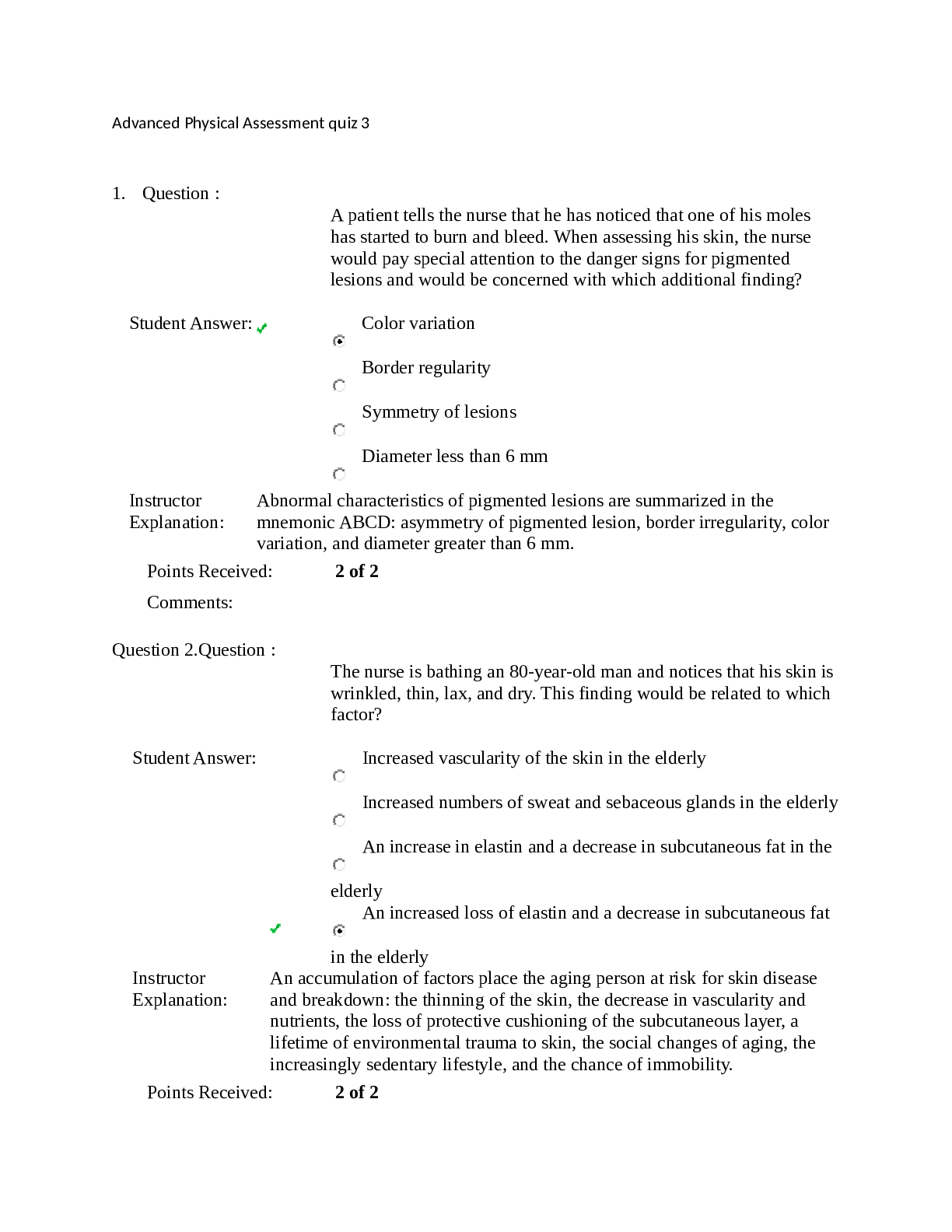
Buy this document to get the full access instantly
Instant Download Access after purchase
Add to cartInstant download
We Accept:

Reviews( 0 )
$9.50
Document information
Connected school, study & course
About the document
Uploaded On
May 19, 2021
Number of pages
12
Written in
Additional information
This document has been written for:
Uploaded
May 19, 2021
Downloads
0
Views
39






.png)






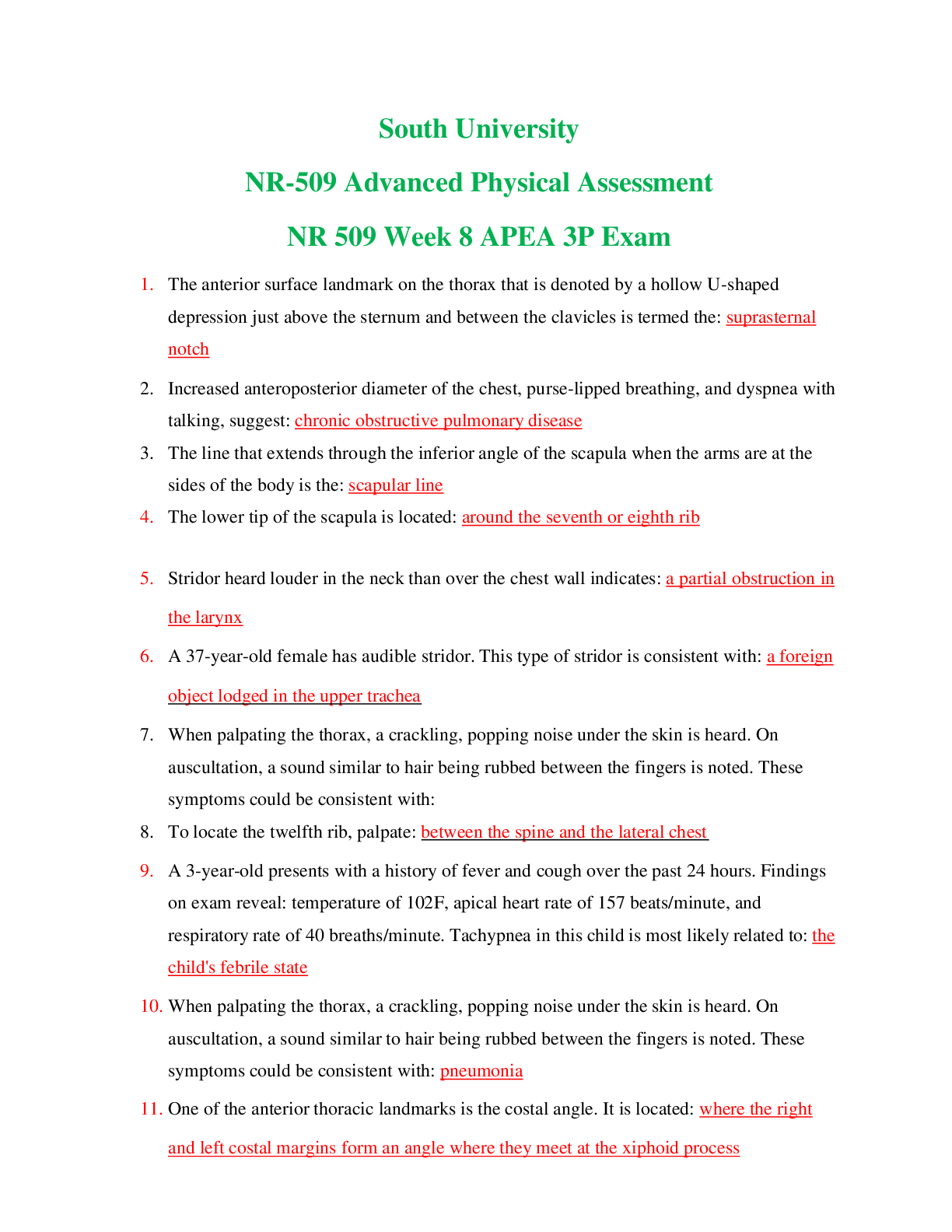

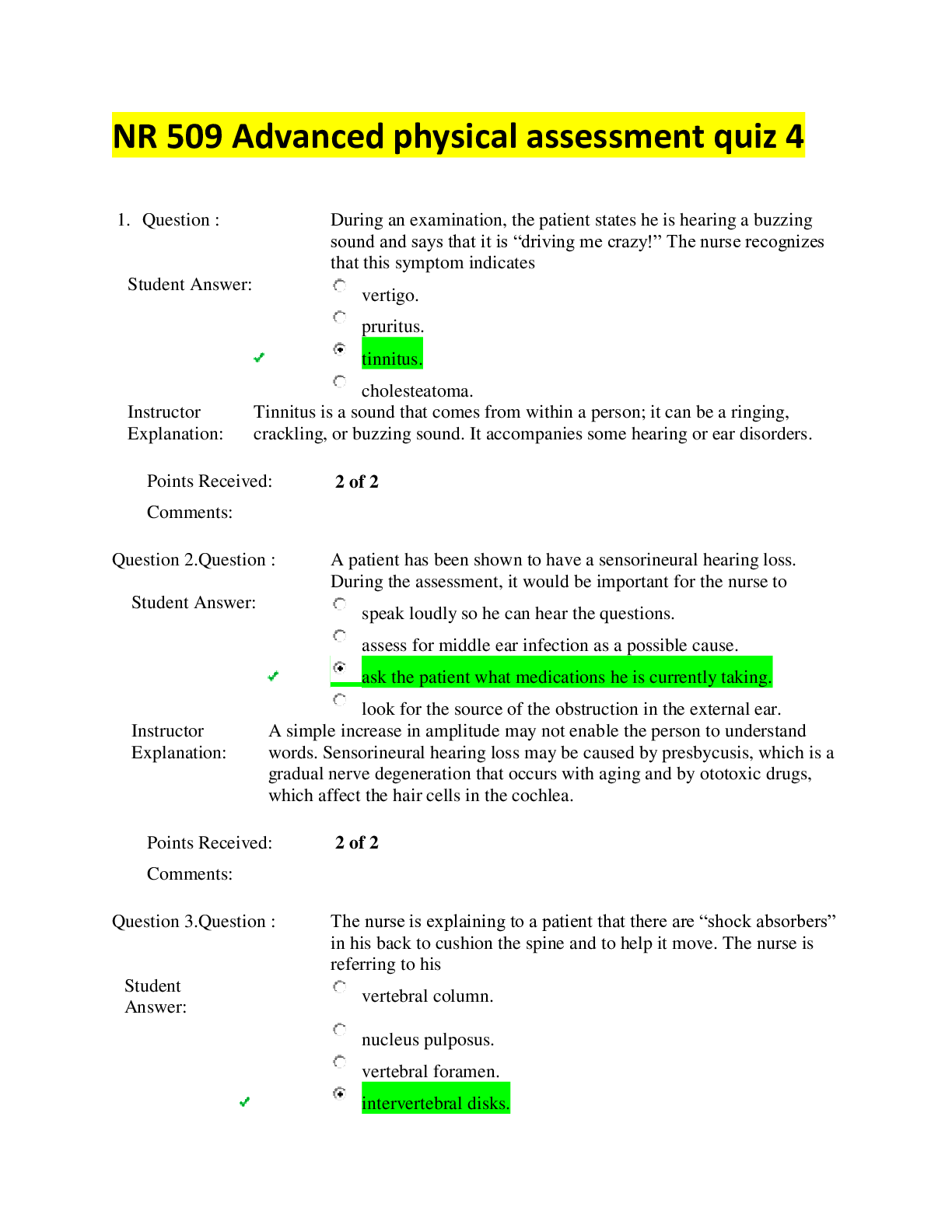
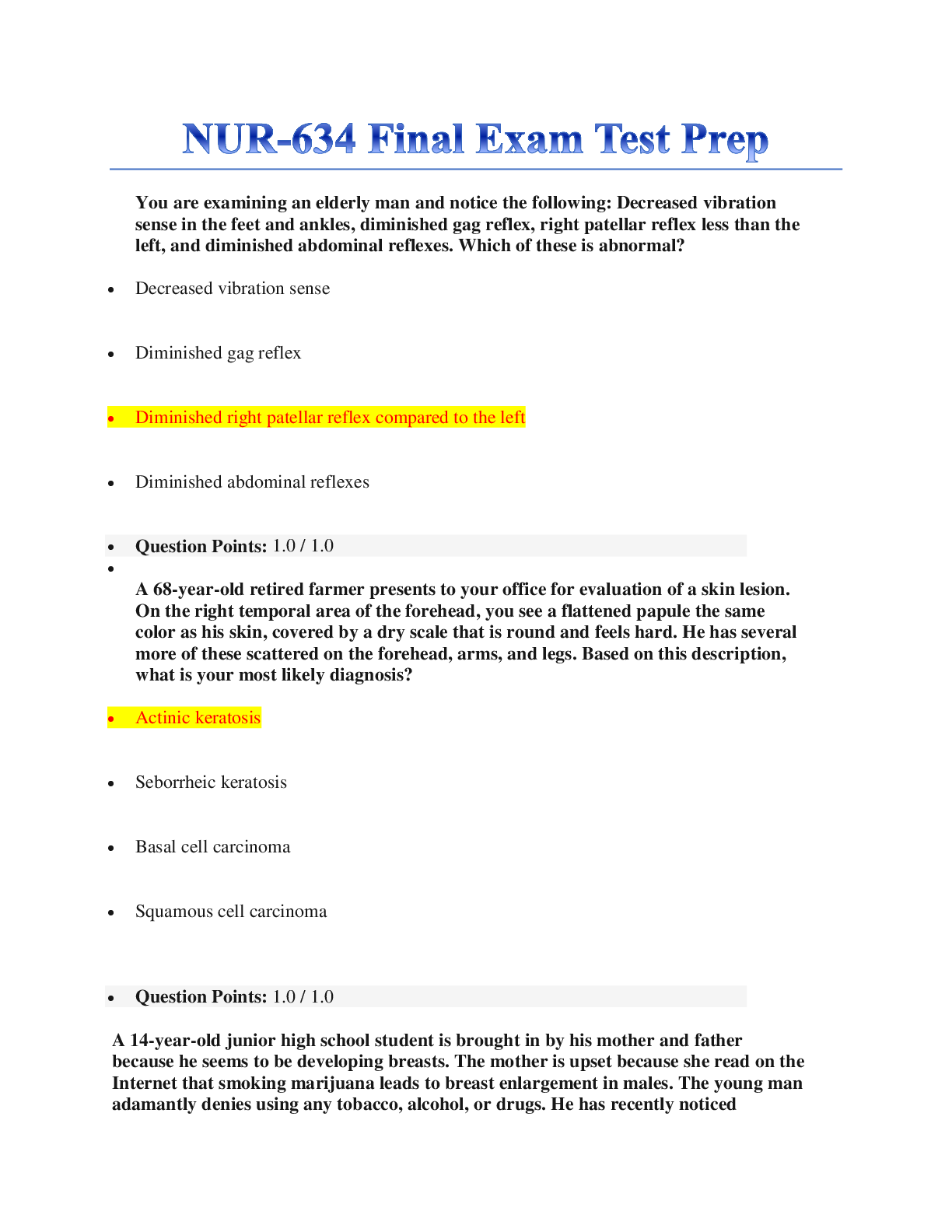
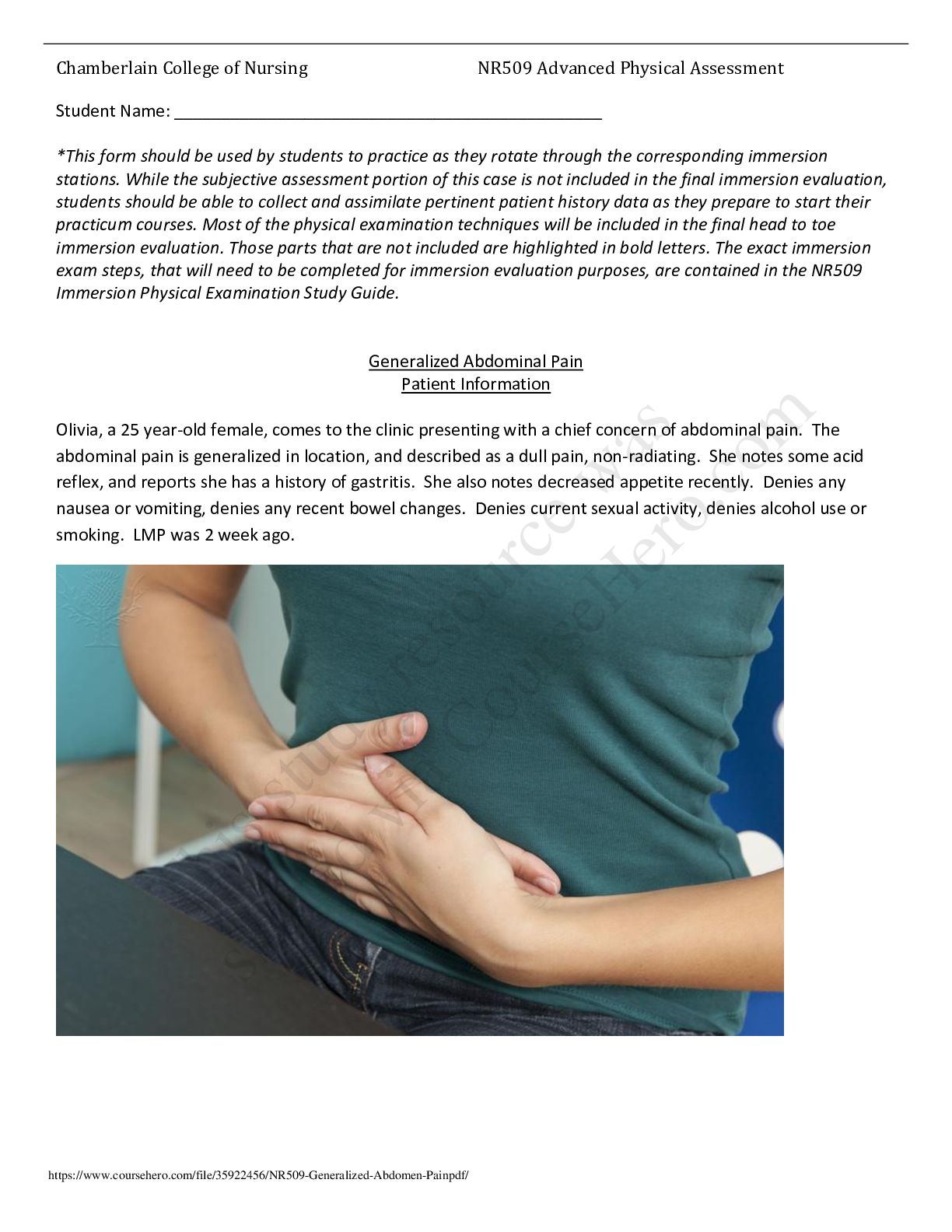
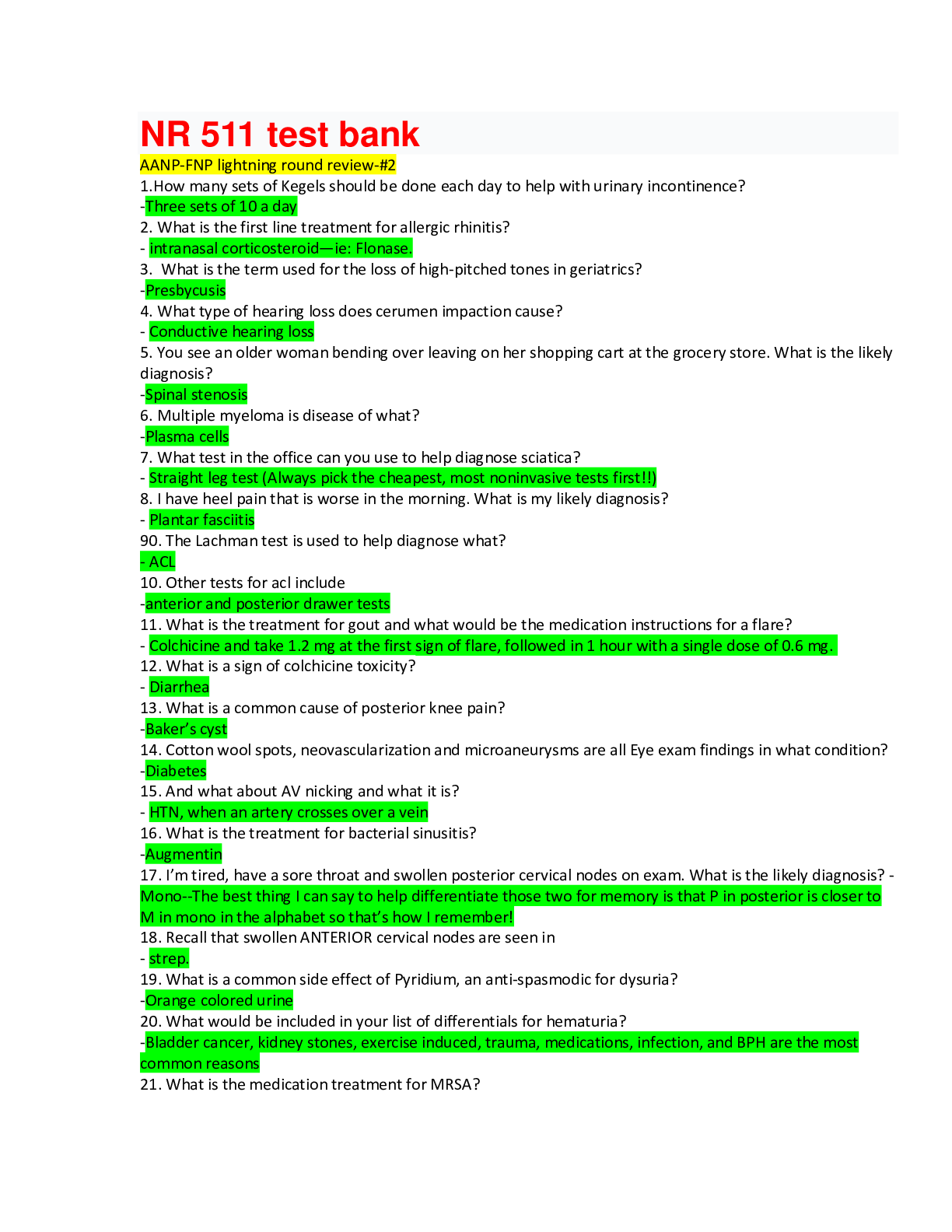
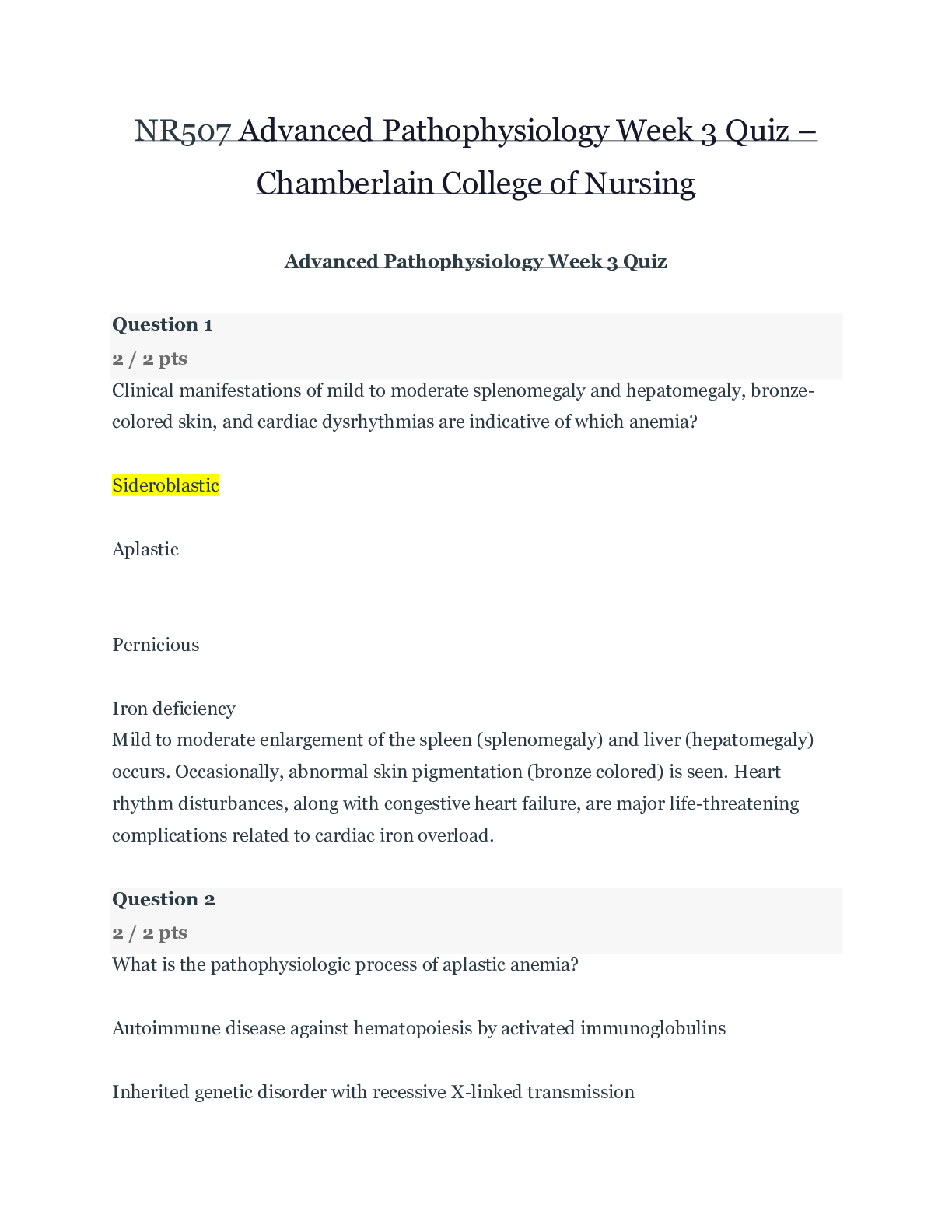
 – Chamberlain College of Nursing.png)
 – Chamberlain College of Nursing.png)

